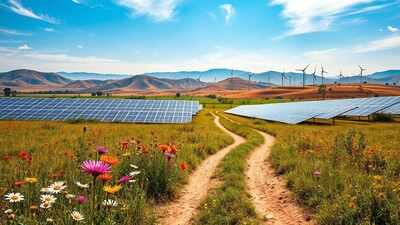
India’s installed power capacity has reached 476 GW as of June 2025, with nearly half, 49% or 235.7 GW, now sourced from non-fossil fuel options, according to a government explainer on energy and environment issued on Sunday. Of this, 226.9 GW comes from renewable energy and 8.8 GW from nuclear sources.Despite this strong push towards clean energy, thermal power, largely driven by coal, remains dominant, accounting for 240 GW or 50.52% of the total installed capacity. Coal alone contributes over 91% of all thermal-based energy, underscoring its vital role in meeting the country’s growing electricity demand, reported news agency PTI.India’s renewable energy sector has witnessed massive expansion, with installed solar capacity growing more than 39 times, from 2.82 GW in 2014 to 110.9 GW in 2025. Wind power stands at 51.3 GW. In total, installed renewable energy has tripled from 76.37 GW in March 2014 to 226.79 GW in June 2025, according to the ministry of new & renewable energy (MNRE).India currently ranks fourth globally in total renewable energy and wind power installed capacity, and third in solar power capacity. Solar PV manufacturing also saw a boom, with module capacity rising from 2.3 GW to 88 GW and cell capacity from 1.2 GW to 25 GW between 2014 and 2025.The government has set a target of 500 GW from non-fossil fuel sources by 2030, and projects under implementation already stand at 176.70 GW, with another 72.06 GW under bidding stages.Power shortages have been nearly eliminated, dropping from 4.2% in 2013–14 to just 0.1% in 2024–25. Simultaneously, per capita electricity consumption jumped 45.8% over the last decade to 1,395 kWh in 2023–24, reflecting improved access and rising energy demand.However, coal continues to receive strong policy and investment backing. Central Coalfields Ltd (CCL), a Coal India subsidiary, is planning to open two new coal mines in FY25 to boost output by 10–12 million tonnes, as per PTI. CMD Nilendu Kumar Singh said the firm is working towards a production target of 150 million tonnes by 2030, up from 87.5 million tonnes produced in FY25.CCL also plans four new washeries with a 14 million tonne capacity in the next 2–3 years to improve coal quality, especially for power and steel sectors. Currently, the company operates 35 open-cast and three underground mines in Jharkhand.As India balances the twin priorities of energy security and decarbonisation, the power sector’s diversified base, ranging from solar and wind to coal and nuclear, positions the country as a key player in the global energy transition.














